

Felice Damiani was born in Gubbio. If the attribution to him of a panel in Santa Maria Maddalena, Spello (see below) is correct, this is his earliest known work. He worked extensively in the Marches, as well as in his native Gubbio.
In his will of 1589, Felice Damiani left his working materials to three of his colleagues: Virgilio Nucci, Pier Angelo Basili and Giovanni Maria Baldassini.
Gubbio
Deposition (1585)
This panel on the high altar of the church of the Monastero delle Cappuccine is [signed by Felice Damiani and dated by inscription ??]
St Ambrose baptizing St Augustine (1594)
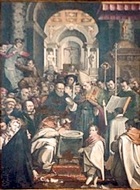
Baptism of Christ (ca. 1599)
This altarpiece, which is by/attributed to Felice Damiani, was originally in the church of Santa Croce del Mercato, which was demolished in 1823. It was moved to Sant’ Ubaldo in the early 20th century.
Baptism of Christ (16th century)
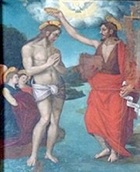
Madonna and Child with saints (ca. 1600)
This altarpiece, which is attributed to Felice Damiani, came from the Cappella di San Romualdo in San Francesco and is now in the the Raccolta d’ Arte in the convent there. It originally depicted the Madonna and Child enthroned with SS Nicholas of Bari, Ubaldus and Romuald. In 1790, this last figure was overpainted by Giuseppe Reposti with a figure of St Francis, who venerates a cross and who is accompanied by the wolf that he pacified in Gubbio. The restoration of the panel in 1998 revealed this over-painting and the arms of the Marioni family, to whom the chapel belonged.
St Vincent Ferrer (16th century)
This altarpiece from San Domenico, which is now in the Museo Diocesano, is by/attributed to Felice Damiani.
St Mary Magdalene (16th century)
This altarpiece by/attributed to Felice Damiani, which was documented in the Cappella di Santa Maria Maddalena (later the baptistery) of San Giovanni Battista, was subsequently lost.
Circumcision of the baby Jesus (1603)
This altarpiece in the left transept of San Domenico is signed by Felice Damiani and dated by inscription. [Three kingdoms ??]
Scenes from the life of St John the Baptist (1604)
Virgilio Nucci was paid in 1604 for the first of this series of 20 panels along the walls of the nave of San Giovanni Decollato. The panels were restored in 1984, along with a contemporary set of panels of scenes from the scenes from the life of the Virgin in Santa Maria dei Laici (above). Following the restoration:
-
✴five are attributed to Virgilio Nucci:
-
•the Annunciation to Zacharius;
-
•the Birth of St John the Baptist;
-
•the Naming of St John the Baptist;
-
•the Massacre of the Innocents; and
-
•St John the Baptist in the Desert;
-
✴eight are attributed to Avanzino Nucci;
-
•the Circumcisione of St John the Baptist;
-
•St John the Baptist preaching;
-
•St John the Baptist introduces Jesus to the crowd;
-
•Salome at the banquet of King Herod;
-
•the dance of Salome;
-
•St John the Baptist in prison;
-
•the beheading of St John the Baptist; and
-
•the burial of St John the Baptist;
-
✴three are attributed to Felice Damiani; St John the Baptist in prison;
-
•Agnus Dei;
-
•St Elizabeth flees with the young St John the Baptist from the Massacre of the Innocents; and
-
•the death of St Elizabeth; and
-
✴four are by one or more inferior artists
-
•the Visitation;
-
•St John baptising people in the River Jordan;
-
•the Baptism of Christ; and
-
•St John the Baptist before Herod.
Scenes from the life of the Virgin (ca. 1607)
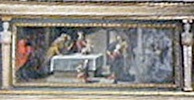
This cycle of 24 panels along the walls of the nave of Santa Maria dei Laici was commissioned from Felice Damiani. The panels were restored in 1984, and it was confirmed that they are mostly by Damiani himself, although a few might be by his workshop. They include this panel of the Circumcision of Christ, which is above the entrance.
Crucifixion with saints (1609)
This late work by Felice Damiani in Sant’ Agostino (in the 2nd chapel on the left) is signed and dated by inscription. The artist actually died in 1608 (and was buried in Sant’ Agostino). The altarpiece was thus presumably completed by his workshop. It depicts SS Mary Magdalene, and Francis kneeling at the foot of the cross, flanked by the Virgin and SS Jerome, John the Evangelist and Antony Abbot.
Franciscan altarpiece (early 17th century)
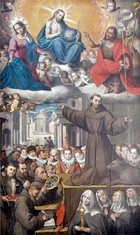
The altarpiece depicts St Francis kneeling beside the docile wolf in what is probably an idealised representation of Piazza Grande. He seems to be preaching to the crowd about the scene above, in which Christ in Judgment is flanked by the Virgin (with a halo of stars that symbolises her Immaculate Conception) and SS John the Baptist and Ubaldus. The stigmata in his right hand and his cord (representing poverty) are prominent. He holds similar cords in his left hand that he presumably intends for those members of his audience who are moved to join the Compagnia del Cordone. A number of Franciscan saints attend the sermon:
-
✴SS Antony of Padua, Bonaventure, Louis of Toulouse, Bernardino of Siena and Louis of France, to the left of the podium; and
-
✴SS Clare and Elizabeth of Hungary with two other Franciscan women below it.
Foligno
Immaculate Conception (1592)
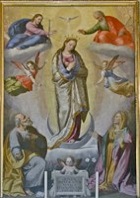
Tota pulchra es, Maria
et macula originalis non est in te
Thou art all fair, O Mary
and the original stain (of sin) is not in thee
Madonna della Cintura (1593)
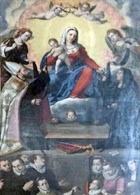
Spello
Birth of St John the Baptist (1575)
This panel on the left wall of the Monastero di Santa Maria Maddalena, which depicts the birth of St John the Baptist, came from the nuns’ earlier church of San Giovanni Battista. It is attributed to Felice Damiani and dated by inscription: if this attribution is correct, it is his earliest known work.
Todi
Deposition (1581)
This altarpiece in the Pinacoteca, which came from [il Convento dei Camaldolesi della Canonica, presso Todi - where is it ??], is signed by Felice Damiani and dated by inscription.

